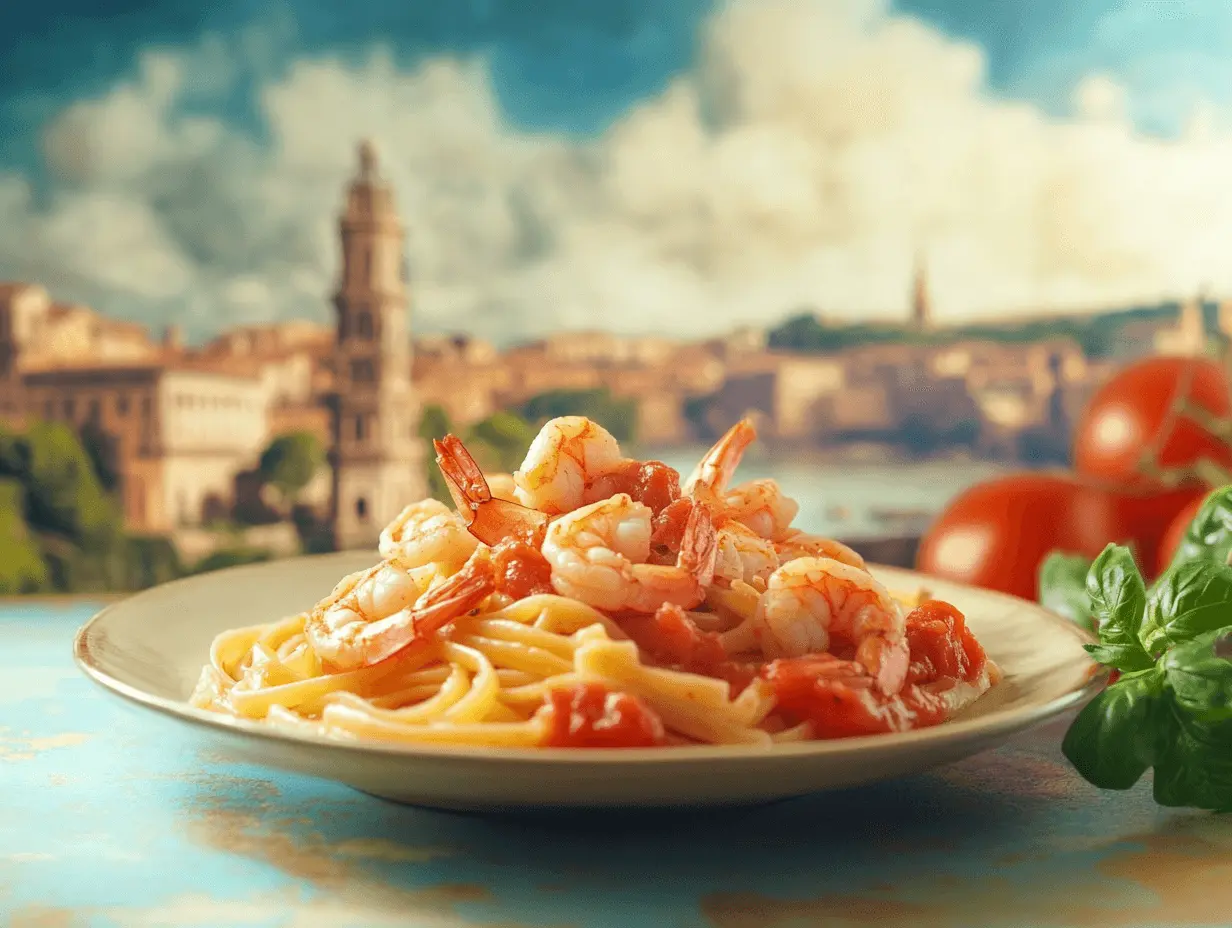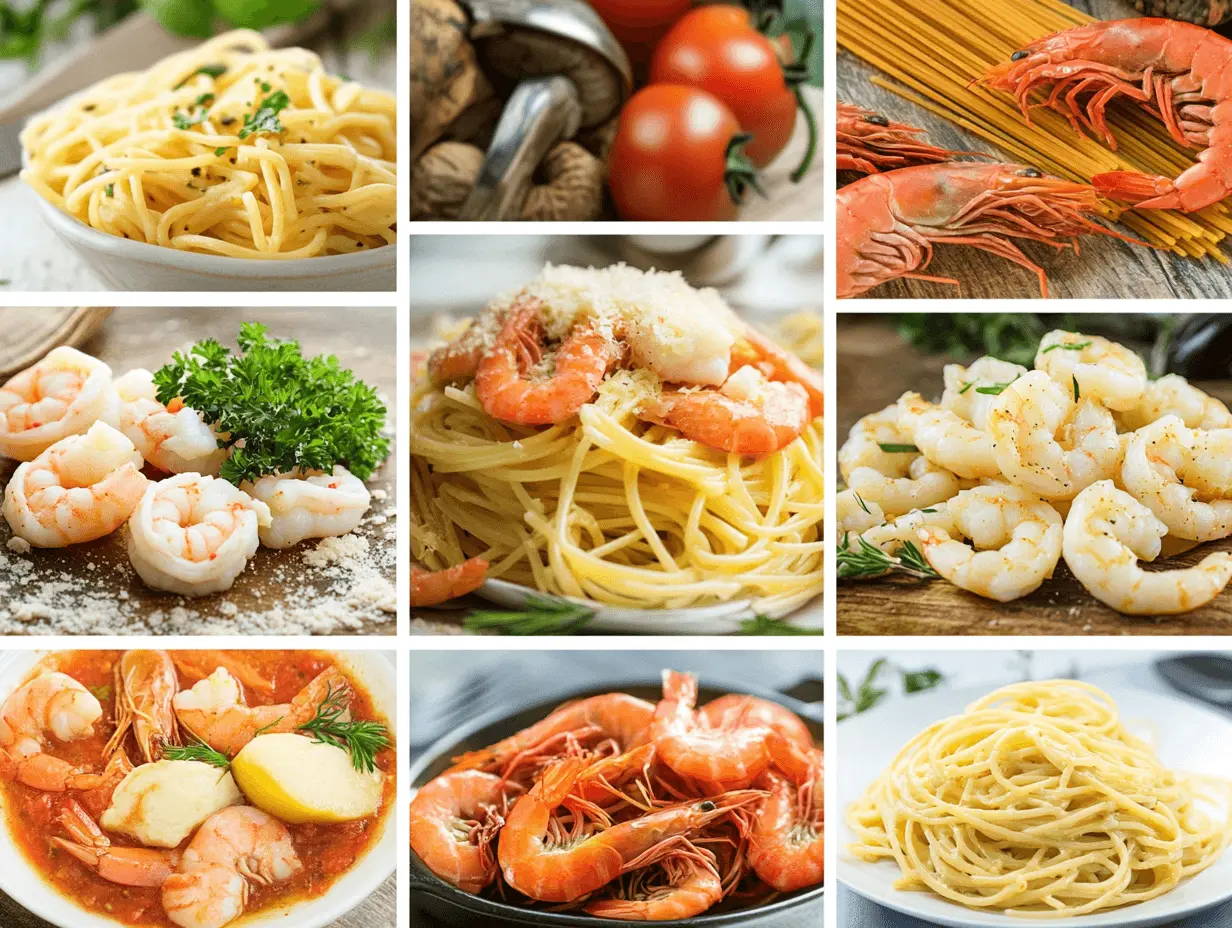Where Did Shrimp Pasta Originate?
Discover the fascinating journey of shrimp pasta, a beloved dish rooted in history and culture, from where shrimp pasta originate to its global culinary fame. This timeless classic is more than just a delicious combination of shrimp and pasta—it’s a story of tradition, adaptation, and innovation.
Introduction
Shrimp pasta is more than just a plate of deliciousness—it’s a story of culinary evolution and cultural fusion. Tracing its origins reveals a tale of ancient traditions, immigrant adaptations, and creative innovations that transformed simple ingredients into an iconic dish. But where did shrimp pasta originate, and how did it gain its global appeal?
This article delves into shrimp pasta’s journey, from its Italian coastal origins to modern global fame. Along the way, it reveals unique regional variations. Additionally, it highlights how Italian-American culture significantly influenced the dish. Each section explores its historical, cultural, and gastronomic importance. By the end, you’ll have a deeper appreciation for this timeless seafood classic.
Historical Background of Shrimp Pasta
Early Use of Shrimp in Culinary Traditions
Shrimp has been a treasured ingredient in seafood-rich regions for centuries. Ancient civilizations along the Mediterranean, such as the Greeks and Romans, frequently included shrimp in their diets due to its abundance in coastal waters. Their love for shrimp wasn’t just about taste; it also symbolized wealth and maritime trade, laying the foundation for where did shrimp pasta originate.
In Ancient Rome, shrimp was a festive meal staple paired with grains, herbs, or honey. Greeks, meanwhile, seasoned shrimp with olive oil and garlic—flavors that became Mediterranean staples. This early love for shrimp paved the way for seafood dishes like shrimp pasta to thrive.
Introduction of Pasta in Italy
While shrimp had its place in early Mediterranean fare, pasta entered the scene later. Its roots can be traced to ancient civilizations, but it was in Italy that pasta truly found its identity. By the 13th century, dried pasta had become a staple in Italian households, prized for its shelf stability and versatility.
Regions such as Naples and Sicily were particularly influential in developing pasta dishes. Coastal towns, where shrimp was readily available, naturally paired this ingredient with their pasta creations. The result? A fusion of two culinary treasures that would eventually evolve into today’s shrimp pasta.
Regional Pasta Variations
Italian cuisine is nothing if not diverse. Northern regions like Liguria introduced their take on seafood pasta, using locally available shellfish and herbs. Meanwhile, southern areas like Campania leaned heavily on tomatoes, garlic, and olive oil to flavor their dishes.
The coastal influence is unmistakable. Proximity to the sea made seafood, especially shrimp, a staple in pasta recipes from these regions. This unique cultural and geographical connection played a pivotal role in creating the shrimp pasta we enjoy today.
The Fusion of Shrimp and Pasta
Italian Coastal Influence
The origins of shrimp pasta are closely tied to Italy’s coastal regions, where access to fresh seafood was a given. Coastal communities, particularly in areas like Liguria, embraced the bounty of the sea, and shrimp quickly became a staple in their culinary repertoire. Combining shrimp with pasta was a logical next step, as it allowed cooks to craft hearty, flavorful meals that could satisfy families with minimal resources.
In Liguria, for instance, recipes often highlighted simplicity. Dishes featured freshly caught shrimp tossed with olive oil, garlic, and parsley—flavors that harmonized effortlessly with the subtlety of pasta. This minimalist approach showcased the natural sweetness of shrimp while celebrating the region’s rich culinary heritage.
Influence of Maritime Trade on Culinary Practices
The spread of shrimp pasta wasn’t confined to local traditions. Maritime trade routes connecting Italy to other parts of the Mediterranean introduced diverse cooking techniques and ingredients, shaping where shrimp pasta originate and how it evolved. Traders brought spices, citrus fruits, and even new types of pasta, all of which enriched the shrimp pasta recipes of the time.
As Italian merchants and sailors traveled, they also shared their food. It’s not far-fetched to imagine an early version of shrimp pasta being cooked aboard ships and later adapted in port towns across Europe. This blend of cultural exchange and coastal living firmly established shrimp pasta as a dish that transcended borders.
Development of Shrimp Scampi
Interestingly, the evolution of shrimp scampi played a pivotal role in the story of shrimp pasta. Traditionally, scampi referred to small lobster-like crustaceans native to the Mediterranean. These were often prepared with butter, garlic, and parsley—a preparation that was eventually adapted to shrimp when Italian cooks moved to regions where scampi was unavailable.
The shrimp scampi we know today, with its buttery garlic sauce, became a cornerstone of many shrimp pasta recipes. This shift not only popularized the pairing of shrimp and pasta but also introduced a level of indulgence that cemented its place in Italian-American cuisine.
Italian-American Adaptation of Shrimp Pasta
Immigration and Culinary Exchange
The 19th and early 20th centuries saw waves of Italian immigrants arriving in the United States, bringing their rich culinary traditions with them. These immigrants, many of whom settled in urban centers like New York City and Chicago, found themselves adapting to new ingredients and cultural influences. Shrimp pasta, or variations of it, began to take root in Italian-American households as a reflection of this cultural exchange.
Italian immigrants adapted traditional recipes using locally available ingredients. For example, while scampi (langoustines) was common in Italy, shrimp became a popular substitute in the U.S. due to its availability. Garlic, olive oil, and fresh herbs remained essential, preserving the dish’s Italian authenticity while embracing its new environment.
Emergence of Shrimp Scampi in American Cuisine
Shrimp scampi’s rise in mid-20th century American restaurants marked a key moment in shrimp pasta’s evolution. Its rich garlic butter sauce paired naturally with pasta, creating the classic shrimp scampi pasta we know today.
Italian-American chefs transformed shrimp pasta from a comforting home dish into a restaurant favorite. Its buttery, garlicky flavors and rich simplicity made it a staple for diners craving authentic Italian-inspired cuisine.
Evolution from Langoustine to Shrimp
Historically, langoustines were the star ingredient in scampi recipes. However, in the U.S., langoustines were hard to come by. This scarcity led Italian-American cooks to use shrimp, which was not only abundant but also had a similar flavor profile. This substitution marked a significant shift in the dish’s identity and was instrumental in shaping the modern concept of shrimp pasta.
American chefs embraced shrimp as a versatile ingredient, experimenting with it in various pasta recipes. This adaptability ensured that shrimp pasta remained relevant across changing culinary trends, solidifying its place in American cuisine.
Regional Variations of Shrimp Pasta
Cajun Shrimp Pasta
In the southern United States, particularly in Louisiana, shrimp pasta underwent a bold transformation with the emergence of Cajun cuisine. Cajun shrimp pasta combines the rich flavors of blackened shrimp with creamy, spiced sauces and often features bold seasonings like paprika, cayenne, and garlic powder.
This version reflects the fusion of French, Spanish, and African influences that define Cajun food. Shrimp, a staple in Louisiana due to its proximity to the Gulf Coast, was a natural fit for the creamy, flavorful pasta dishes popular in the region. Over time, Cajun shrimp pasta became synonymous with comfort food, celebrated for its vibrant taste and indulgent texture.
Origins in Louisiana Cuisine
The roots of Cajun shrimp pasta lie in the resourcefulness of Cajun settlers. Using fresh local shrimp and pantry staples like cream, butter, and spices, they created hearty meals that could feed large families. This resourcefulness, combined with Louisiana’s rich culinary history, gave rise to a dish that’s both satisfying and deeply flavorful.
Today, Cajun shrimp pasta is a favorite not only in Louisiana but also nationwide, often served with crusty bread to soak up every last drop of its creamy sauce.
Mediterranean Shrimp Pasta
On the other side of the world, Mediterranean shrimp pasta offers a lighter, fresher take on the dish. This variation often incorporates ingredients like olive oil, tomatoes, lemon, and fresh herbs such as basil and parsley. The result is a vibrant and zesty dish that highlights the natural sweetness of shrimp.
Greek and Spanish Influences
In Greek cuisine, shrimp pasta is often prepared with orzo and seasoned with oregano, dill, and lemon. Meanwhile, in Spain, seafood pasta dishes may include saffron, paprika, and even peppers, creating a more robust flavor profile. These regional variations demonstrate how shrimp pasta can adapt to different culinary traditions while retaining its core appeal.
Unique Flavor Profiles
Mediterranean shrimp pasta beautifully balances acidity, sweetness, and earthiness. Prepared with wholesome, fresh ingredients, it’s both lighter and flavorful, making it a healthier yet satisfying choice.
Modern Interpretations of Shrimp Pasta
Contemporary Culinary Trends
Today, shrimp pasta has evolved beyond its historical roots, taking on new forms in kitchens worldwide. Modern chefs and home cooks alike have embraced the dish’s versatility, experimenting with a variety of ingredients, techniques, and presentations. Whether it’s vegan-friendly versions using plant-based shrimp or gluten-free pasta for health-conscious diners, shrimp pasta has adapted to meet contemporary demands.
Fusion cuisine has also played a significant role in redefining shrimp pasta. In Asian-inspired kitchens, for example, shrimp pasta dishes might incorporate soy sauce, ginger, or sesame oil, creating a savory umami twist. These creative adaptations ensure that shrimp pasta’s origin story remains relevant in today’s globalized culinary landscape.
Fusion with Other Cuisines
The melding of Italian tradition with global influences has led to exciting innovations in shrimp pasta. Take shrimp Alfredo pasta, for instance—a creamy, indulgent American-Italian invention that showcases the dish’s adaptability. Similarly, Southeast Asian-inspired shrimp pasta might feature chili, coconut milk, and lime, creating bold, spicy flavor profiles.
By combining elements from different cuisines, these interpretations pay homage to where shrimp pasta originated while pushing its boundaries.
Health-Conscious Adaptations
Shrimp pasta’s nutritional profile has made it a favorite for health-conscious eaters. Shrimp itself is low in calories and high in protein, making it an excellent choice for balanced meals. Pairing it with whole-grain or zucchini noodles has become a common practice, offering a lighter alternative to traditional pasta.
Additionally, recipes now frequently use olive oil instead of butter or cream, enhancing the dish’s heart-healthy qualities. These adaptations allow shrimp pasta to appeal to a broader audience, proving its enduring versatility and appeal.
Shrimp Pasta in Popular Culture
It’s not just taste buds that love shrimp pasta—it has also carved out a space in pop culture. From food shows to restaurant menus, shrimp pasta often represents sophistication and comfort in equal measure. Its appearance in films, cookbooks, and social media has elevated its status, turning it into a symbol of indulgence and culinary artistry.
The global popularity of shrimp pasta clearly demonstrates just how far this beloved dish has traveled from where shrimp pasta originated. Furthermore, it continues to captivate food lovers, chefs, and critics alike, firmly maintaining its place as a timeless classic while effortlessly adapting to modern culinary trends.
Frequently Asked Questions (FAQs)
What is the origin of shrimp scampi?
Shrimp scampi originated in Italy as a dish traditionally made with langoustines, a type of small lobster-like crustacean, cooked with olive oil, garlic, and parsley. When Italian immigrants brought the recipe to America, they substituted langoustines with shrimp due to availability, giving birth to the now-famous shrimp scampi. This adaptation played a key role in shaping modern shrimp pasta dishes.
How did Cajun shrimp pasta develop?
Cajun shrimp pasta, originating in Louisiana, skillfully blends French, African, and Spanish culinary traditions. Notably, it features blackened shrimp, creamy sauces, and bold spices like cayenne and paprika, which highlight its rich, layered flavors. Moreover, it reflects the ingenuity of Cajun settlers, who relied on Gulf Coast shrimp and pantry staples to create hearty, flavorful meals that endure as a culinary favorite.
What are common ingredients in traditional shrimp pasta dishes?
Traditional shrimp pasta recipes typically include shrimp, olive oil, garlic, parsley, and pasta (often linguine or spaghetti). Depending on the region, additional ingredients like tomatoes, cream, or butter might be added. Italian-inspired versions often emphasize simplicity and fresh flavors, while variations like Cajun shrimp pasta incorporate bold seasonings and rich sauces.
How has shrimp pasta evolved over time?
Shrimp pasta has evolved from a coastal Italian specialty into a global favorite, staying deeply connected to where did shrimp pasta originate. The dish started with simple preparations in Mediterranean fishing villages, combining fresh shrimp with handmade pasta. Over time, cultural exchanges and regional adaptations introduced new ingredients and techniques, resulting in variations like creamy Alfredo-based shrimp pasta and spicy Cajun versions.
What are some popular variations of shrimp pasta worldwide?
Popular shrimp pasta variations include Cajun shrimp pasta, Mediterranean shrimp pasta, and shrimp Alfredo pasta. Asian-inspired versions might feature soy sauce or chili, while health-conscious adaptations use whole-grain or zucchini noodles. Each variation reflects the dish’s ability to adapt to local tastes and culinary traditions.
How is shrimp pasta typically served in different cultures?
In Italy, shrimp pasta is often served simply with olive oil, garlic, and fresh herbs, staying true to where did shrimp pasta originate. In the U.S., creamy versions like shrimp Alfredo are popular, while Cajun shrimp pasta is a spicy comfort food in the South. Mediterranean versions emphasize light, fresh flavors with tomatoes and citrus, reflecting regional preferences.
Conclusion
So, where did shrimp pasta originate? Its roots lie in the coastal regions of Italy, where fresh shrimp and handmade pasta came together to create a simple yet flavorful dish. Over centuries, this culinary treasure evolved, crossing borders and adapting to new ingredients and techniques. From the bustling markets of Liguria to the innovative kitchens of America, shrimp pasta reflects the creativity and resilience of those who made it their own.
Today, shrimp pasta is more than just a meal—it’s a symbol of cultural exchange and timeless appeal. Whether enjoyed in its traditional Italian form, with garlic and olive oil, or as a spicy Cajun creation, shrimp pasta continues to bring people together. Its story reminds us that food is a universal language, connecting us to history and to each other.
Next time you savor a plate of shrimp pasta, think about its journey—from where shrimp pasta originated to the global sensation it has become—and enjoy every bite of its rich, layered history.


